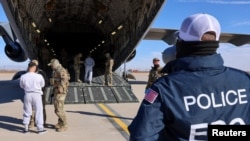The first undocumented migrants — described by U.S. officials as the "the worst of the worst" — are being held in jail cells at the U.S. detention center at Guantanamo Bay, Cuba, waiting to be sent home.
The Pentagon Wednesday confirmed 10 "high-threat illegal aliens" arrived Tuesday at the detention facility, where they are being held under the watch of officers with U.S. Immigration and Customs Enforcement, or ICE.
VOA first reported on the transfer — and arrival — of the migrants, flown from Fort Bliss, Texas, to Guantanamo Bay aboard a U.S. military C-17 cargo plane Tuesday.
According to the Pentagon, the detention of the high-threat migrants at the Guantanamo Bay detention facility is a temporary measure.
ICE "is taking this measure to ensure the safe and secure detention of these individuals until they can be transported to their country of origin or other appropriate destination" the Pentagon said in a statement.
U.S. Homeland Security Secretary Kristi Noem on Tuesday posted photos on X of some of the migrants as they prepared to board the military cargo plane, calling them "the worst of the worst," and warning the effort to deport them is just getting started.
The Department of Homeland Security later said all of the migrants on the military flight were members of Tren de Aragua, a Venezuelan street gang with transnational reach. Officials did not say when or how they were first taken into custody.
The White House has announced plans to designate Tren de Aragua as a Foreign Terrorist Organization.
Noem, posting on X on Wednesday, said her department has overseen the arrest of "convicted murderers, rapists, child abusers, drug traffickers, MS-13 gang members, cartel members," in just the past few days.
Since President Donald Trump's executive order last month, the Pentagon has deployed 300 Marines to Guantanamo to expand the facilities to support holding operations for undocumented immigrants. According to media reports, they have set up tents to house the migrants inside a fenced area at a separate part of the naval base. Those facilities are not yet ready for migrants, according to Fox News.
"The number of service members will continue to fluctuate as additional forces are tasked to deploy and will be scaled, based on the requirements of the Department of Homeland Security, which is the lead federal agency," U.S. Southern Command, which oversees operations in South America, Central America and the Caribbean, announced in a statement on Monday.
The migrants who arrived Tuesday will be held at the U.S. detention facility, according to a U.S. official who spoke on background. The facility is known mostly for housing military prisoners and terror suspects, including those involved in the September 11, 2001, attacks and members of the Taliban.
"If you're a violent gang banger, and you've been taken out of our country, and we're waiting to bring you to your country, we're going to put you in a cell box built for al-Qaida," Secretary of Defense Pete Hegseth told Fox News this week.
In his executive order last month, Trump instructed the departments of Defense and Homeland Security to prepare the U.S. naval base to hold up to 30,000 migrants.
"Some of them are so bad we don't even trust the countries to hold them because we don't want them coming back. So, we're going to send them out to Guantanamo," Trump said.
Closing Guantanamo
Democratic administrations under former Presidents Barack Obama and Joe Biden had sought to close the detention camp, which was built by the administration of former President George W. Bush in 2002, following the U.S. invasion of Afghanistan that began shortly after the 9/11 attacks of 2001.
Sue Hendrickson, president and CEO of Human Rights First, said in a statement that sending migrants to Guantanamo would create a human rights catastrophe.
"The Trump administration may find the symbolism of sending migrants to Guantanamo darkly appealing; its practical result would be more injustice, waste and self-inflicted loss of credibility," Hendrickson said.
At its height during the global war on terror campaign, the detention facility held about 680 prisoners. As of January 6, there were just 15 detainees at the facility, according to the Pentagon.
Before being used to detain terror suspects, the U.S. naval facility was also used to house migrants from Cuba and Haiti in the early 1990s.
Patsy Widakuswara, Aline Barros contributed to this report.









